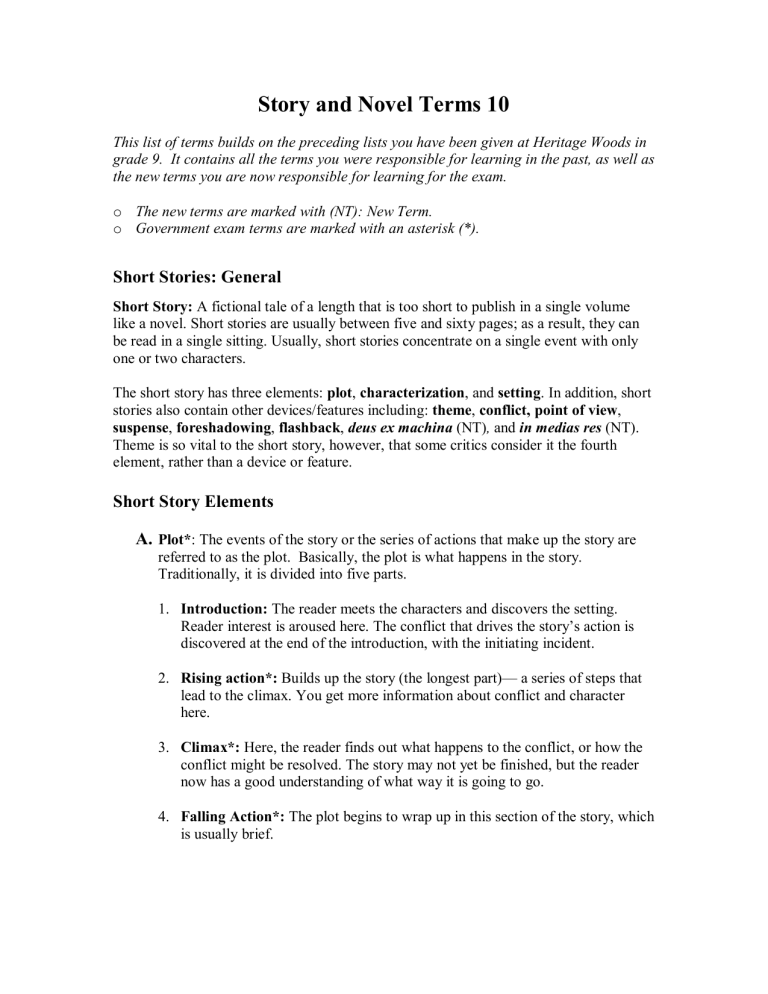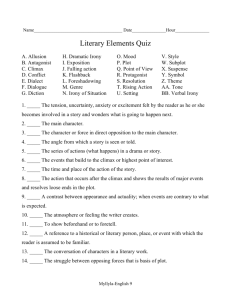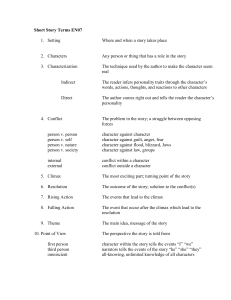Short Story & Novel Terms: Grade 10 Study Guide
advertisement

Story and Novel Terms 10 This list of terms builds on the preceding lists you have been given at Heritage Woods in grade 9. It contains all the terms you were responsible for learning in the past, as well as the new terms you are now responsible for learning for the exam. o The new terms are marked with (NT): New Term. o Government exam terms are marked with an asterisk (*). Short Stories: General Short Story: A fictional tale of a length that is too short to publish in a single volume like a novel. Short stories are usually between five and sixty pages; as a result, they can be read in a single sitting. Usually, short stories concentrate on a single event with only one or two characters. The short story has three elements: plot, characterization, and setting. In addition, short stories also contain other devices/features including: theme, conflict, point of view, suspense, foreshadowing, flashback, deus ex machina (NT), and in medias res (NT). Theme is so vital to the short story, however, that some critics consider it the fourth element, rather than a device or feature. Short Story Elements A. Plot*: The events of the story or the series of actions that make up the story are referred to as the plot. Basically, the plot is what happens in the story. Traditionally, it is divided into five parts. 1. Introduction: The reader meets the characters and discovers the setting. Reader interest is aroused here. The conflict that drives the story’s action is discovered at the end of the introduction, with the initiating incident. 2. Rising action*: Builds up the story (the longest part)— a series of steps that lead to the climax. You get more information about conflict and character here. 3. Climax*: Here, the reader finds out what happens to the conflict, or how the conflict might be resolved. The story may not yet be finished, but the reader now has a good understanding of what way it is going to go. 4. Falling Action*: The plot begins to wrap up in this section of the story, which is usually brief. 5. Denouement/Conclusion/Resolution*: This part follows quickly after the climax and provides the last pieces of information for the reader. “Denouement” is French for “unknotting”; you may therefore think of denouement as the “unknotting” or “untangling” of the plot. Other words for denouement are conclusion or resolution (think about it as the resolution of the climax). However, not all conclusions provide resolution. 5.A. There are four types of conclusions (all NTs) and they have a variety of names: 1. Expository Happy: All loose ends are tied up and explained and the ending is happy. 2. Expository Sad: All loose ends are tied up and explained and the ending is sad. 3. Surprise or Twist: Something happens that the reader does not expect at all. 4. Unresolved/Indeterminate/Cliffhanger: The reader is left with questions and has to, in part, supply the ending him or herself. Some loose ends are left to dangle. 5.B. Anti-Climax: A dull or disappointing ending to something after increasing excitement. For example: After the weeks of preparation, the concert itself was a bit of an anticlimax. In connection to a story or novel, it means an ending that doesn’t measure up to the plot events that precede it (the ending is anti-climactic). (NT) Plot Diagram: Also known as Freytag’s Pyramid, the story diagram or plot diagram, was invented in 1864 by Gustav Freytag to visually represent the five plot parts and their relationship with one another. Modern stories may or may not tidily fit Freytag’s Pyramid. Climax Rising action Introduction Initiating inciden Fallin action Conclusion/Denouement B. Characterization: The collection of characters, or people, in a short story is called its characterization. A character*, of course, is usually a person in a story, but it can also be an animal (think about Flounder the fish in Disney’s Ariel or Simba in Disney’s The Lion King or the dogs in 8 Below). (NT) Character Types • Protagonist*: The main character in the story. The protagonist is usually, but not always, a “good guy.” • Antagonist*: The force against the protagonist. The antagonist is usually another character, but not always, especially if the conflict is “person against self.” The antagonist is usually described as “the bad guy”, although that description doesn’t work if the conflict is person against self or person against environment. • Flat*: This is a minor character with one or maybe two sides to the personality. These characters might not seem very realistic or life-like because so little is known about them. • Round*: These characters are believable and complex people with several sides to their personality. They are lifelike and behave like real people would, if real people were in those same situations. • Dynamic*: Also known as a kinetic character, a dynamic character changes in some important way because of plot events. For example: a cruel old man might see the error of his ways and become generous and kind, or a gentle girl becomes vicious and angry because her parents divorce. • Static*: These characters are the opposite of dynamic characters. These people don’t change through the course of a story. They have the same personality throughout. • Stereotypical*: Also known as stock, these characters are people who are easily recognized as “types”. It wouldn’t matter in which story they appear, they are always the same. For example, the old witch-like woman, the geeky scientist, the airhead, and the dumb jock characters are all stereotypical, or stock, characters. In this sense, they are also clichés* (NT). (A cliché is an over-used expression, like “light as a feather,” or an over-used idea, like the stereotypical characters just discussed.) • Character Foil*: A character foil, or simply “foil”, occurs when two characters balance each other in some way; they are almost like two halves of a whole person. This is when a character is portrayed as opposite of another character in a particular way. By putting the two characters next to each other, the different characteristic is emphasized. This helps readers recognize particular characteristics. A good person might be a foil for an evil person, for example. (NT) Character Analysis: The author may choose any of six ways to reveal a character to the reader. The reader must therefore be prepared to watch for "clues" about each character in these same six ways: 1. physical appearance 2. things the character says 3. things the character does (actions) 4. things the character thinks 5. things other characters say about the character 6. author information Character Sketch: A character sketch is a description of a character's moral and personality qualities, written in paragraph form with specific examples from the story in question. Usually, the character terms (see above) are used in the course of the description. Physical appearance and dress (if showing something about personality) are sometimes described as well. C. Setting*: The author may choose to state the setting clearly or leave it to the reader to infer from textual clues (such as weather). There are two parts to a complete setting: emotional and physical. The mood* (or atmosphere*) of a story is the emotional setting, so readers need to concentrate on words that evoke feeling and emotion. The time, place, and season comprise the physical setting, so readers need to concentrate on words that describe physical details. Short Story Devices and Features A. Theme*: The message of the story, stated in one or two complete sentences. When a person describes a story’s theme, the person is describing what can be learned about life and/or people from the story. Theme is so important, it is often described as the fourth element of the short story. Sometimes theme is confused with “the moral” of the story. B. Conflict*: Conflict drives the plot forward. The reader discovers the conflict by the end of the introduction with the initiating incident, which is an event that demonstrates the conflict to the reader and begins the rising action. Either internal or external conflict can be the main conflict of a story and therefore the primary driver of the plot: • Internal Conflict*: When the conflict is inside a character in a short story/ novel as an internal struggle. Usually characters, like real people, have conflicting fears and goals that cause them to behave in certain ways. These secret conflicts (secret from the other characters in the text) represent the character’s internal conflict. The reader, of course, is aware of the internal conflict because he/she can see the character’s thoughts. (NT) • External Conflict*: When the conflict is outside a character in a short story/ novel. External conflict is the opposite of internal conflict, in that the conflict is obvious to all the other characters in the story, as well as the reader. External conflict is best described as the adversities faced by the character during the plot. (NT) Additionally, there are four different categories of conflict: • Person versus person • Person versus self • Person versus environment • Person versus the supernatural/machine C. Point of View*: The writer selects the point of view from which to tell the story that best suits his/her intentions as a writer • First Person*: “I” is the central character and tells his or her own story. • Second Person: The story is told about “you”; for example, “You could see the anger in her eyes.” • Third Person where the point of view can be one of: o Omniscient*: Characters are referred to as “he” and “she”, and the reader knows what is going on in their heads. All characters’ thoughts are made clear in the text. (NT) o Limited Omniscient*: Characters are referred to as “he” and “she”, and the reader knows what is going on in some of their heads. The remaining characters are treated in the objective fashion. (NT) o Objective*: The story is about “he” or “she”, and the author records action objectively, as a movie camera would. The reader does not see any of the character’s thoughts (doesn’t get inside their heads). (NT) D. Deus ex Machina: From the Latin "god out of the machine." This device refers to any artificial device that is not a natural extension of the plot that allows for an easy– and unbelievable—resolution of conflict. Deus ex machina is an improbable plot event. (NT) E. In Medias Res: Beginning in the middle of the action. A sample beginning to such a story: “I saw the punch coming but couldn't duck in time. I collapsed to the floor, nose gushing red, clotted blood.” (NT) F. Flashback*: When a character thinks back to an event that occurred before the story began. Sometimes flashbacks are written as separate “interrupter” sections within a novel. Flashbacks are also used in short stories. G. Foreshadowing*: A hint of events to come. Also used extensively in both novels and short stories. H. Suspense*: Anxiety or apprehension resulting from an uncertain, undecided, or mysterious situation. Suspense is when the writer creates excited anticipation of an approaching climax in the reader. Novels Many of the terms associated with short stories are also used in novels, particularly setting, characterization, plot, and theme. The difference between a novel and a short story is in the length and complexity of the narrative. Novels are longer and more complex than short stories; therefore, they take several sittings to read in their entirety. Novels, like short stories, can be written in different style categories or sub-genres*. The different sub-genres include mystery, science fiction, fantasy, romance, history, and contemporary, to name a few. Style*: Writers use many, many different techniques to attract reader interest and attention or to accomplish their literary purpose in short stories, novels, poems and plays. Several such stylistic techniques follow here: • Antithesis: The use of contrast, or opposition, for effect. In creative writing, antithesis is a rhetorical device where a sentence or two contains a balanced contrast of ideas, so either the two halves of a single sentence, or the two sentences placed side-by-side, show complete contrast for powerful effect. For example, “Give me liberty ,or give me death!” (NT) • Chronological Order*: Writers often choose to describe plot events in chronological order, meaning the events happen one after another and are not told in a mixed-up way. With a chronological approach, first things first, second things second, and so on… (NT) • Diction*: An author’s choice and arrangement of words in a literary work. Diction varies according to the ends a writer wishes to achieve as well as to the nature of the literary form, the subject, and the style of the day. The ornate style of much eighteenth-century prose, therefore, was considered elegant in its time but would be deemed wordy in a contemporary essay. (NT) • Direct Presentation*: Writers who provide information directly to their readers are using direct presentation. Readers can locate specific information about a character, for example, by finding it right in the text. (NT) • Indirect Presentation*: Writers often choose indirect presentation in order to inform their readers about their characters or other story elements. Indirect presentation of information requires readers to use their inference skills, as the specific information is shown rather than told to the reader. (NT) • Irony*: There are three different kinds of irony. o Verbal irony occurs when the opposite of what is said is actually meant (sarcasm is an extreme form of verbal irony). (NT) o Situational irony occurs when an event occurs that is the opposite of what was expected by the character and/or reader. (NT) o Dramatic irony is when a character says something, but the audience/reader knows more than the character does about other characters or events, so the statement comes across with a double meaning that the audience/reader “gets” and the character doesn’t. (NT) • Narration*: Something that is narrated—an account, a story, a novel–is a narration. Actually telling the story via the process of narrating is also narration, so “narration” is a verb as well as a noun. (NT) • Narrator*: The teller of the story or the person speaking in the story. (NT) • Paradox*: A statement, person, or situation that seems to be contradictory or opposed to common sense; it is an unusual pairing of non-matching (incongruous) ideas. Authors use paradox to provoke insight, so while a paradoxical statement appears to contradict itself, it often, on closer examination, reveals a truth. In Shakespeare’s Romeo and Juliet, for example, Juliet paradoxically refers to Rome as her “only love, sprung from [her] only hate.” “The child is the father of the man” (William Wordsworth) is also a paradoxical statement. (NT) • Satire*: A style of writing that has the goal of mocking or scorning an individual, an institution, or society as a whole. Angry and bitter satire is called Juvenalian satire while gentle mockery is called Horatian satire. • Sarcasm*: When a character (or person) uses verbal irony to express bitter or angry feelings about something. The reverse of what is meant is said. For example, a person might say, “That’s an act of genius!” when he really means it is the act of a fool. (NT) • Symbol*: A symbol has two levels of meaning: a literal level and a figurative level. Objects, characters, events and settings can all be symbolic in that they represent something else beyond themselves. E.g. the dove is literally a bird, but it has become a universal symbol of peace. The collection of symbols in a novel or short story is called symbolism*.



